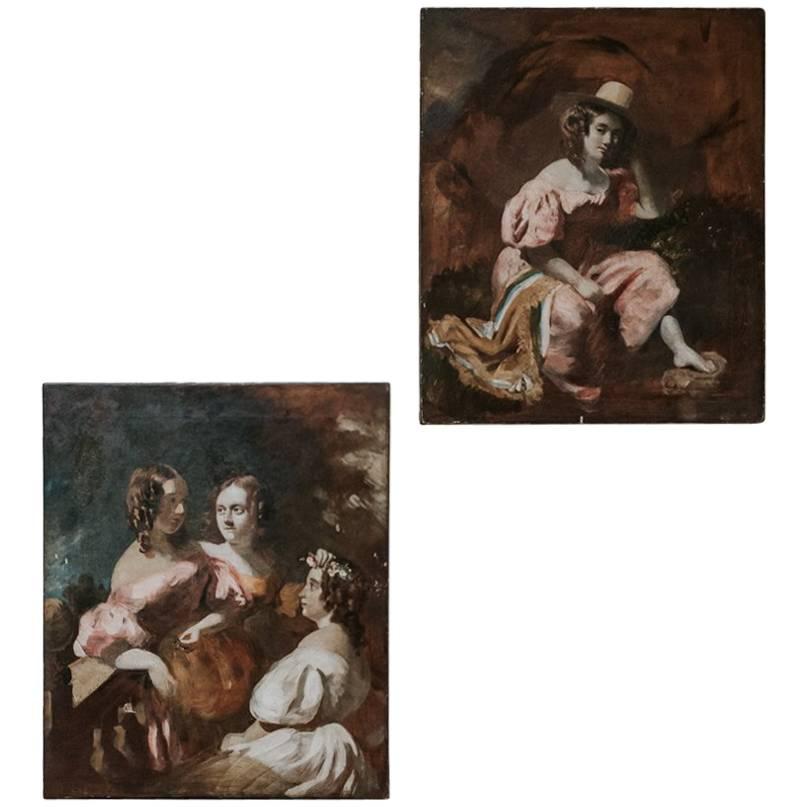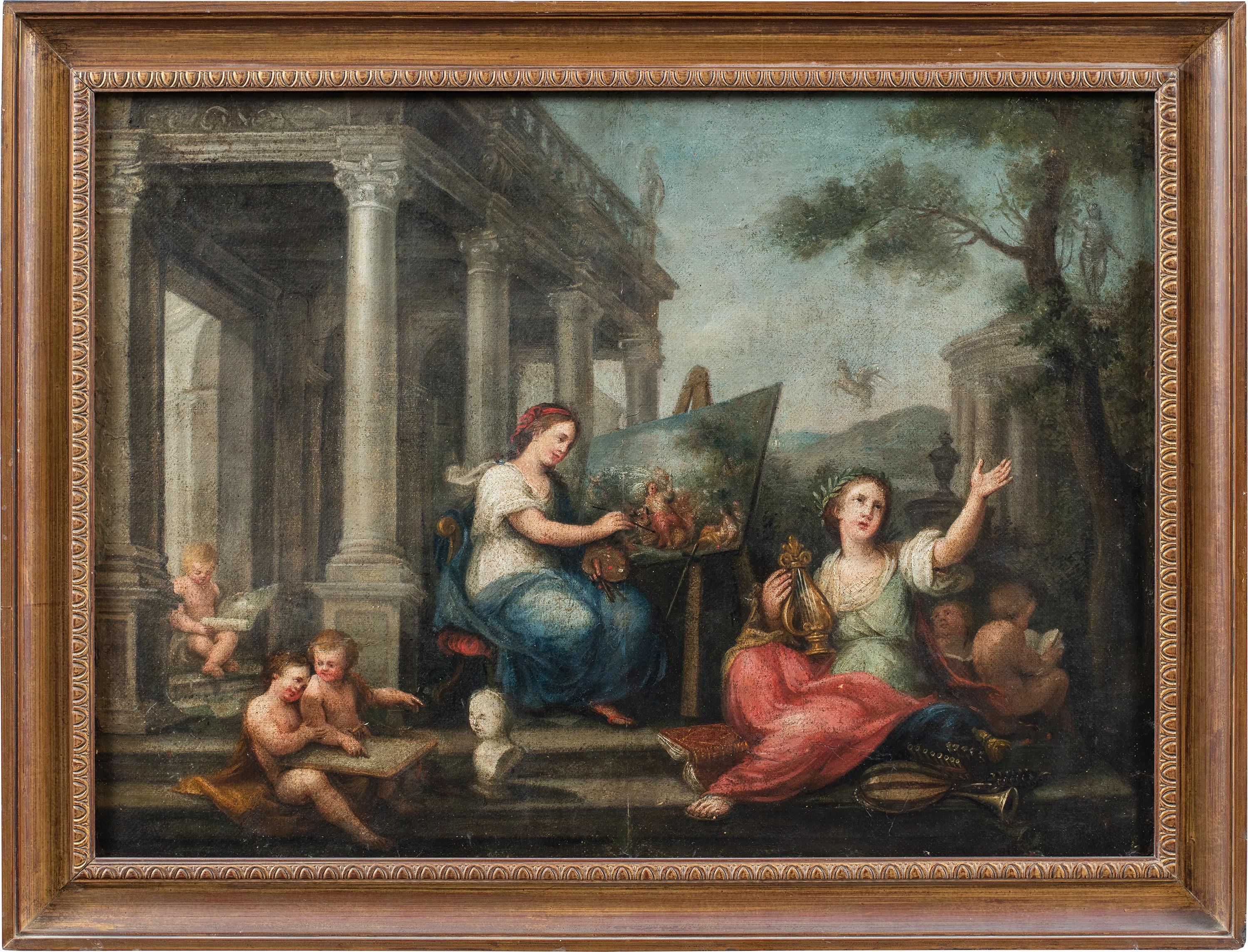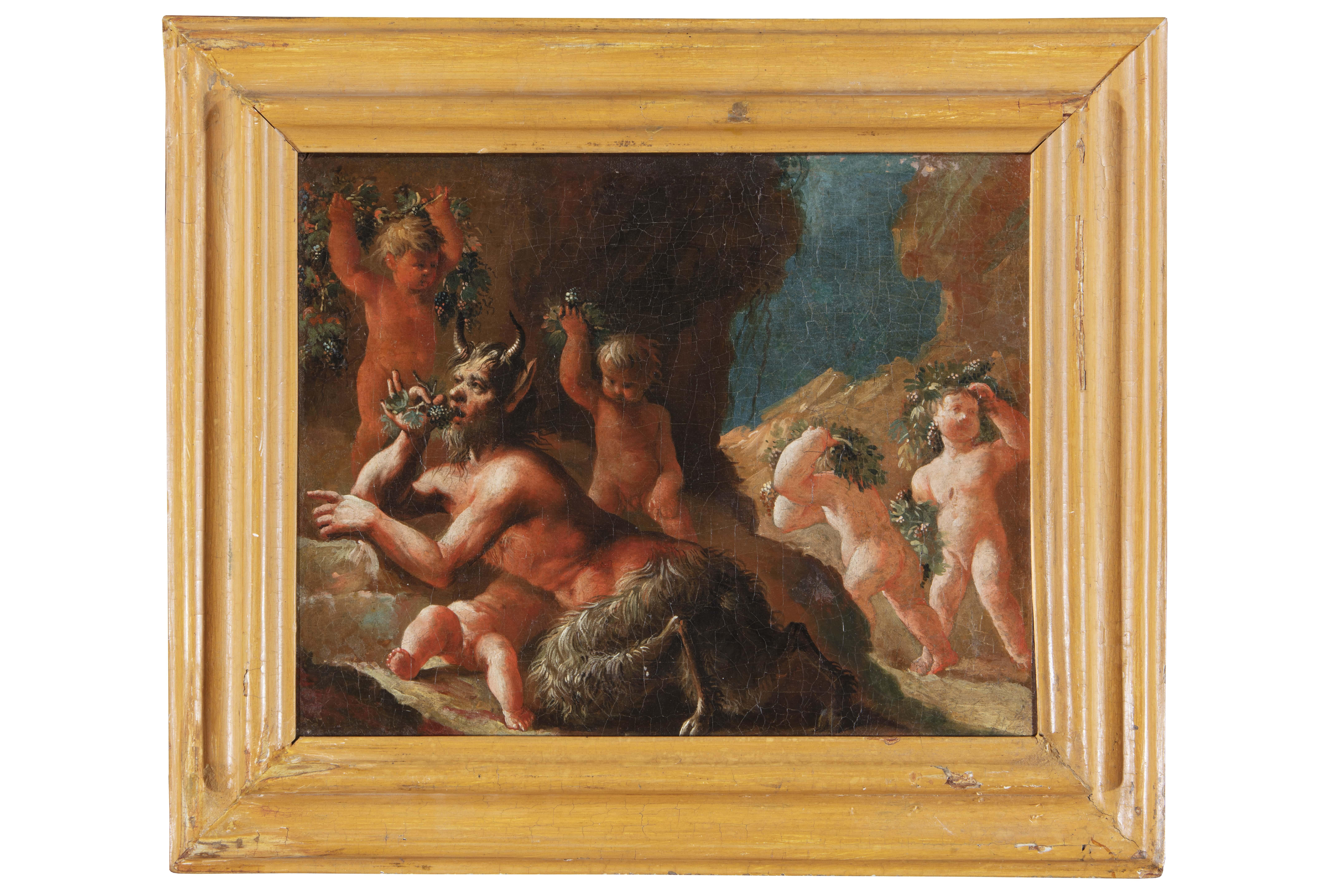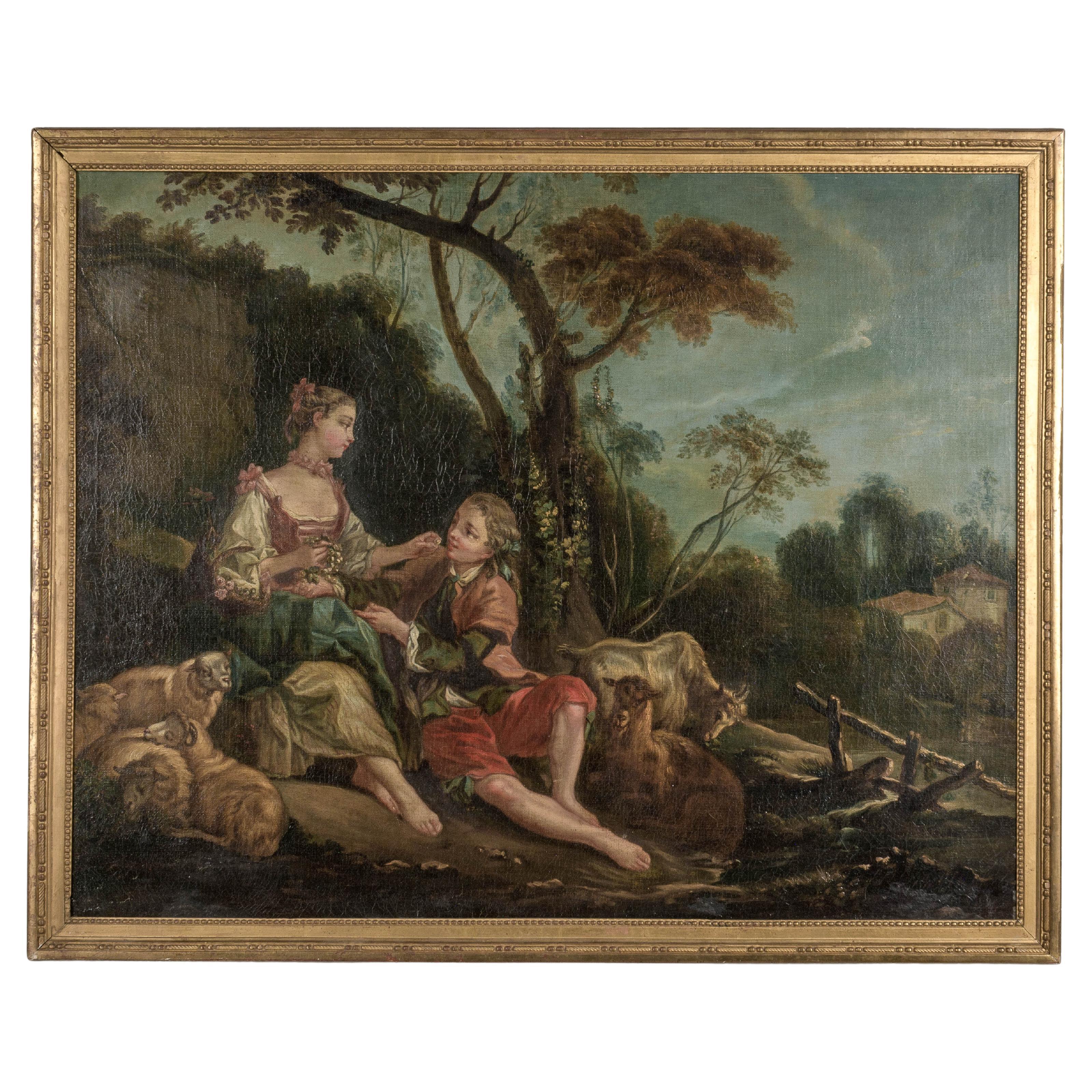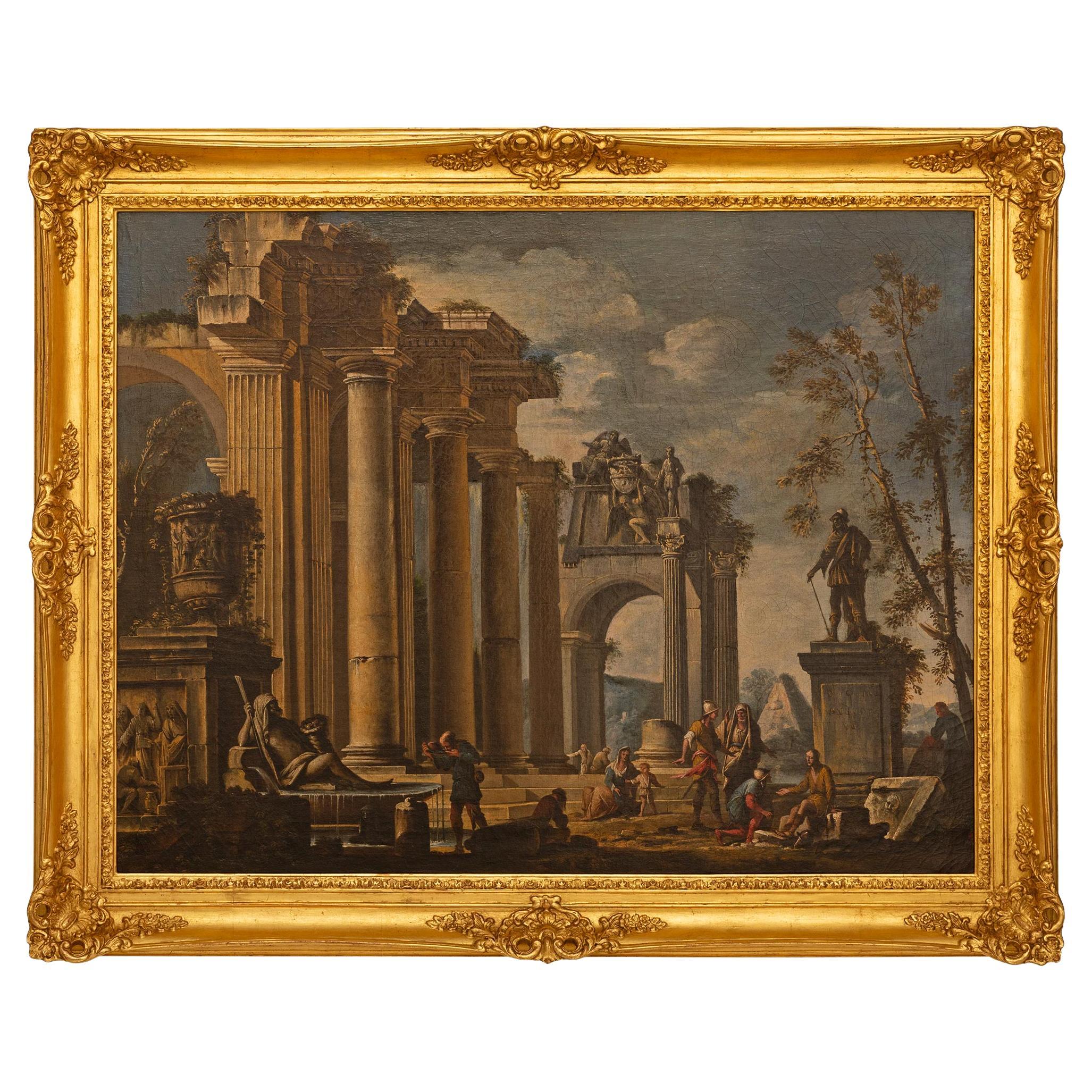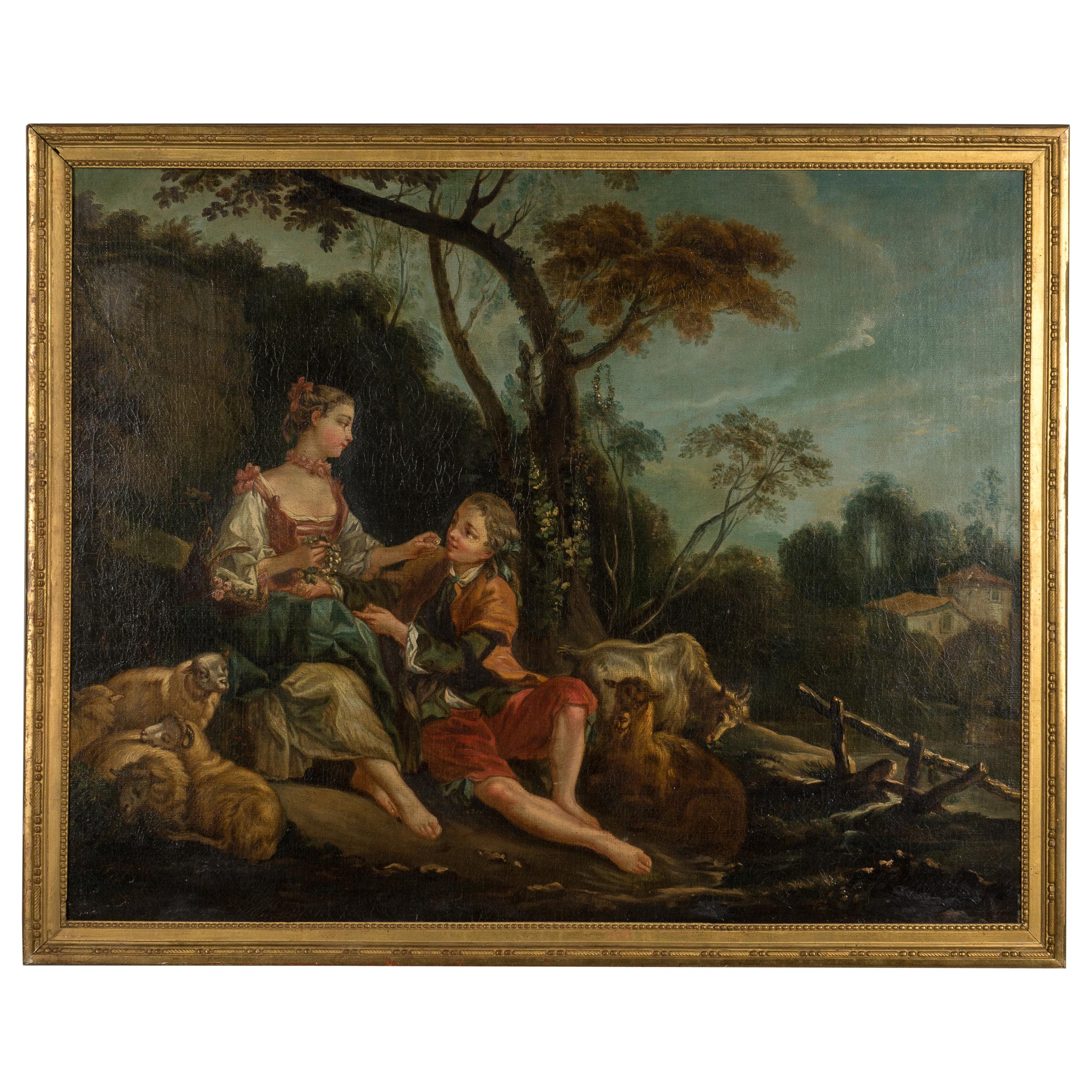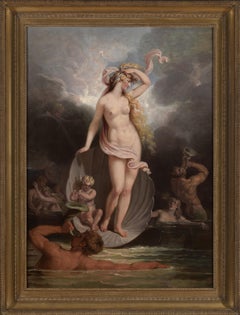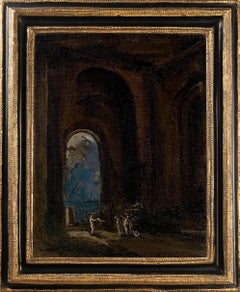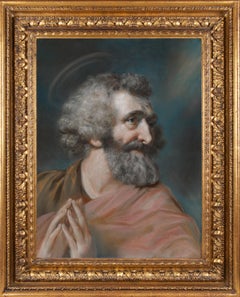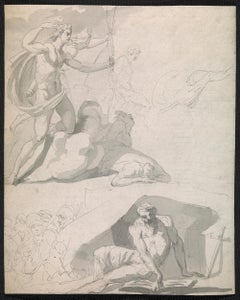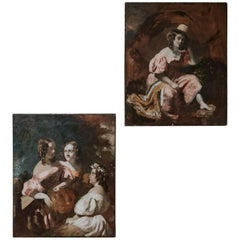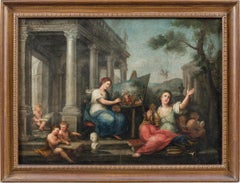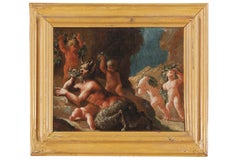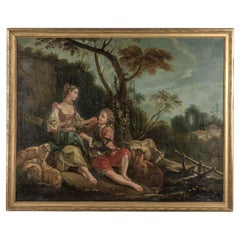Items Similar to 18th century oil sketches for a Baroque interior - a pair
Want more images or videos?
Request additional images or videos from the seller
1 of 9
Louis Chéron18th century oil sketches for a Baroque interior - a pairCirca 1710
Circa 1710
$242,140.28
£175,000
€207,281.76
CA$331,513.53
A$367,673.06
CHF 193,083.87
MX$4,515,286.58
NOK 2,444,258.38
SEK 2,304,968.40
DKK 1,546,549.94
Shipping
Retrieving quote...The 1stDibs Promise:
Authenticity Guarantee,
Money-Back Guarantee,
24-Hour Cancellation
About the Item
A FEAST OF THE GODS WITH VENUS AND BACCHUS
Collections:
With Appleby Brothers, London, June 1957;
Hazlitt, Gooden & Fox, London, 1961;
John and Eileen Harris, acquired from the above, to 2015.
Literature:
Jacob Simon and Ellis Hillman, English Baroque Sketches: The Painted Interior in the Age of Thornhill, 1974, cat. no.12 (as by Louis Laguerre);
Elizabeth Einberg (ed.), Manners and Morals: Hogarth and British Painting, 1700-1760, exh. cat., London (Tate Gallery), 1987, cat. no.10 (as by Louis Laguerre);
Tabitha Barber and Tim Bachelor, British Baroque: Power and Illusion, exh. cat., London (Tate Britain), 2020.
Exhibited:
Twickenham, Marble Hill House, English Baroque Sketches: The Painted Interior in the Age of Thornhill, 1974, no.12 (as by Louis Laguerre);
London, Tate Gallery, Manners and Morals: Hogarth and British Painting, 1700-1760, 1987, no.10 (as by Louis Laguerre);
London, Tate Britain, British Baroque: Power and Illusion, cat. no 92, 2020.
CUPID AND PSYCHE BEFORE JUPITER
Collections:
With Appleby Brothers, London, June 1957;
Hazlitt, Gooden & Fox, London, 1961;
Anthony Hobson, acquired from the above, to 2015.
These recently re-united paintings are the most ambitious surviving baroque ceiling sketches made in Britain in the early eighteenth century. From the Restoration until the rise of Palladianism in the 1720s decorative history painting formed the preeminent artistic discipline in Britain. It was a field dominated by Continental artists including the Italian Antonio Verrio and the Frenchmen Louis Laguerre and Louis Chéron (1660-1725). The present paintings have recently been identified as being by Chéron having long been attributed to Laguerre. Executed on an unusually grand scale, the sketches were almost certainly preparatory for one of the great interior schemes of the early eighteenth century.
Louis Chéron was born in Paris on 2 September 1660 into a notable French protestant family of artists, the son of a miniature painter and an engraver, and the younger brother of Elizabeth-Sophie Chéron a notable painter and engraver. Chéron trained at the Académie under Charles Le Brun and Noel Coypel, then in Rome from 1676. He twice won the prix de Rome twice, in 1676 and 1678; on the first occasion he received financial help from his sister to visit Italy. His earlier biographer, Dezallier d’Argenville states that Chéron claimed: ‘Quand on lui demandoit qui etoit son maître, il nommoit Raphael.’ Two albums of Chéron’s drawings, many made in Italy, testify to this allegiance, with thirty sheets after Raphael’s frescos in Rome which were, according to Vertue, ‘always much valyed & esteemed amongst the curious.’ Back in Paris he received a number of commissions, notably in 1687 and 1690 from the Guild of Goldsmiths for paintings to be presented in May of those years to the cathedral of Notre Dame in Paris. Studies for the 1687 painting, The Prophecy of Habbakuk (Musée du Louvre).
Chéron decided to leave France, no doubt spurred by the persecution of Huguenots following the revocation of the edict of Nantes in 1685. He is recorded in the registers of the Huguenot congregation at the Savoy Chapel in London in 1693 and was naturalized in 1710. His going to London was possibly at the suggestion of Ralph, first earl and later duke of Montague, for whom in 1695 in the recently completed Boughton House, Northamptonshire, he painted a number of ceilings, including those of the saloon and the staircase, with mythological scenes. The album in the British Museum contains six drawings for the drawings at Boughton. He also worked in London at Montague House, at Ditton Park, Buckinghamshire, at Burghley House, Northamptonshire, and in the gallery and little dining-room at Chatsworth House, Derbyshire. In 1709 he was one of five artists invited to submit designs for the dome of St Paul's Cathedral.
The present paintings are unusually large sketches made in preparation for what must have been one of Chéron’s grandest decorative cycles. The oil sketches show that the ceilings were to be composed of an illusionistic sky populated by a pantheon of gods. The swirling mass of Baroque figures demonstrates Chéron’s appeal; bringing a Continental language of decoration to English interiors. The sketches seem likely to date from about 1710 but are currently unrelated to a specific project. The first Cupid and Psyche before Jupiter reprises the subject-matter Chéron had used at Boughton on the ceiling of the Little Hall. As at Boughton, the present sketch shows a multitude of figures seated on clouds, on the left hand side the figure of seated Minerva, on the right the figure of Mars and a seated figure of Mercury; in the centre of the composition Jupiter, with a large eagle at this feet, also identifiable are the figures of Venus, Bacchus and Hercules, Flora and Diana. Chéron’s sketch is structured around architectural elements; Telamons support an entablature and the cloud supporting Venus and her attendants break onto the wallspace, suggesting the scheme was also designed to include the decoration of the rest of the room. Compositionally the sketch of Cupid and Psyche is close to the work Chéron carried out at Burghley, particularly The Marriage of Hercules and Hebe on the ceiling of the Great Hall. The composition and approach – particularly the vertical dynamism - are similar: the seated figure of Jupiter at the centre of the composition is close to the figure of Jupiter at the centre of the Cupid and Psyche before Jupiter.
The ceiling design of The Feast of the Gods is even more architectonic. The assemblage of gods – identical to the figures found in Cupid and Psyche before Jupiter – are shown bursting through a frieze of Telamons supporting an entablature. The riotous composition displays the illusionistic grandeur of Chéron’s most mature compositions. Narratively the pair of designs are closely related and clearly formed part of a programme of decoration for two conjoining rooms. The architectural decoration is also similar in both designs, but the visual emphasis is slightly different. In Cupid and Psyche before Jupiter, the action is more condensed and immediate suggesting the design is for a smaller room than The Feast of the Gods.
These two oil sketches first appeared on the market in June 1957 when they were with Appleby Brothers in London and attributed to James Thornhill. The canvases were with Hazlitt, Gooden & Fox by 1961 when they were sold separately to the great architectural historian John Harris and the eminent bibliophile Anthony Hobson. It was Harris who suggested that the canvases were by Laguerre by the time he lent The Feast of the Gods to the exhibition English Baroque Sketches: The Painted Interior in the Age of Thornhill held at Marble Hill in 1974. The Feast of the Gods was then lent to the important exhibition: Manners & Morals: Hogarth and British Painting 1700-1760 held at the Tate Gallery in 1987 as the single example of a great French Baroque ceiling design from the period. More recently they paintings have been identified as the work of Chéron and The Feast of the Gods was shown at the Tate’s major Baroque exhibition in 2020 as by Chéron.
These large sketches are two of the most ambitious surviving oil studies made by the most significant decorative history painter in Britain in the early eighteenth century. They neatly illustrate the prevailing fashion for Baroque, illusionistic decoration which dominated British interiors in the first decades of the eighteenth century. Chéron was a highly important figure within the London art world and Vertue’s obituary notice stressed that he was: ‘of an affable good natur’d temper. very communicative of his Art with a plain open sincerity that made him most agreeable & belv’d. living regular & sober.’ Vertue adds after Chéron’s posthumous sale: ‘many sketches for works that he did as several noblemans houses. for the Duke of Montague at Boughton & at Ditton. Duke of Devonshire at Chatsworth. Duke of Whartons. The Earl of Exeter.’ Suggesting that these two remarkable sketches may ultimately be identified with a great, lost scheme at one of these houses and that the sketches themselves were in Chéron’s studio at his death.
- Creator:Louis Chéron (1660 - 1725, French)
- Creation Year:Circa 1710
- Dimensions:Height: 36 in (91.44 cm)Width: 48.13 in (122.26 cm)
- Medium:
- Movement & Style:
- Period:
- Condition:Both paintings are preserved in excellent condition, in twentieth century gilt-wood frames.
- Gallery Location:London, GB
- Reference Number:1stDibs: LU150727718822
About the Seller
5.0
Recognized Seller
These prestigious sellers are industry leaders and represent the highest echelon for item quality and design.
1stDibs seller since 2021
- ShippingRetrieving quote...Shipping from: London, United Kingdom
- Return Policy
Authenticity Guarantee
In the unlikely event there’s an issue with an item’s authenticity, contact us within 1 year for a full refund. DetailsMoney-Back Guarantee
If your item is not as described, is damaged in transit, or does not arrive, contact us within 7 days for a full refund. Details24-Hour Cancellation
You have a 24-hour grace period in which to reconsider your purchase, with no questions asked.Vetted Professional Sellers
Our world-class sellers must adhere to strict standards for service and quality, maintaining the integrity of our listings.Price-Match Guarantee
If you find that a seller listed the same item for a lower price elsewhere, we’ll match it.Trusted Global Delivery
Our best-in-class carrier network provides specialized shipping options worldwide, including custom delivery.More From This Seller
View All18th century allegorical painting of The Triumph of Beauty
Located in London, GB
Exhibited:
London, Royal Academy, 1800, no. 93
What was happening in British history painting in around 1800? In recent discussions of the emergence of a British School of history painting following the foundation of the Royal Academy in 1768, this is a question which is rarely posed and one which is not easily answered. Examination of surviving Royal Academy exhibition catalogues reveals a profusion of artists’ names and titles, few of which remain immediately recognizable, whilst endeavours to explain the impact of exhibition culture on painting - such as the 2001 Courtauld show Art on the Line - have tended to focus on the first and second generation of Royal Academician, rather than young or aspiring artists in the early nineteenth century. This makes the discovery and identification of the work under discussion of exceptional importance in making sense of currents in English painting around 1800. Executed by Edward Dayes...
Category
18th Century Old Masters Figurative Paintings
Materials
Canvas, Oil
20th century oil painting entitled The Unknown Corner
Located in London, GB
Collections:
Robert Isaacson;
James Draper, New York, 2014.
Exhibited:
Cambridge, The Fitzwilliam Museum, Beggarstaffs: William Nicholson and James Pr...
Category
Early 20th Century Modern Figurative Paintings
Materials
Canvas, Oil
18th century portrait of the Royal Academy model George White
By John Russell
Located in London, GB
Collections:
Russell sale, Christie’s, 14 February, 1807: ‘John Russell, Esq., R.A. deceased, crayon painter to His Majesty, the Prince of Wales, and Duke of York; and brought from his late Dwelling in Newman Street’, lot 92, ‘St Peter’, bt. Thompson (£1.13s);
Anonymous sale; Sotheby's, London, 25th September 1980, lot 113;
Private collection, UK, 2016.
Literature:
Martin Postle, 'Patriarchs, prophets and paviours: Reynolds's images of old age', The Burlington Magazine, vol. cxxx, no. 1027, October 1988, pp. 739-40, fig. 9;
Martin Postle, Sir Joshua Reynolds: The Subject Pictures, Cambridge, 1995, p.136, repr.;
Neil Jeffares, Dictionary of pastellists before 1800, online edition, J.64.2928.
Signed and dated: J Russell/ fecit 1772 (lower right)
Framed dimensions: 25 x 31 inches
John Russell was admitted to the Royal Academy in March 1770, at the same time as Daniel Gardner. The nascent Academy Schools were still establishing their teaching structures, but central to the syllabus were the twin components of drawing after the antique and from life models. By 1772 Russell had already been awarded a silver medal and progressed to the life academy, where he produced this remarkable pastel study of George White. White was the most famous model employed by the Royal Academy and prominent artists in the second half of the eighteenth century. A paviour – or street mender –by profession White had been discovered by Joshua Reynolds, who in turn introduced him to the Academy. Russell’s striking head study demonstrates his abilities as a portraitist and pastellist, at the same time showing his interest in the Academy’s preoccupation with promoting history painting.
George White was one of the most celebrated models in eighteenth-century London. According to the painter Joseph Moser:
'Old George…owed the ease in which he passed his latter days, in a great measure to Sir Joshua Reynolds, who found him exerting himself in the laborious employment of thumping down stones in the street; and observing not only the grand and majestic traits of his countenance, but the dignity of his muscular figure, took him out of a situation to which his strength was by no means equal, clothed, fed, and had him, first as a model in his own painting room, then introduced him as a subject for the students of the Royal Academy.'
As Martin Postle has pointed out, whilst characterful studies of old men posed as biblical figures, prophets or saints by Continental old masters were readily available on the art market – Reynolds himself had copied a head of Joab by Federico Bencovich in the collection of his friend and patron, Lord Palmerston - finding a model in Britain from whom to execute a painting was more difficult.
White therefore offered a rare opportunity for artists to combine portraiture and history painting, by painting a model in the guise of an historical or literary character. In 1771 Reynolds showed at the Royal Academy a picture of White entitled Resignation. It was engraved in 1772 and accompanied by a stanza from Oliver Goldsmith’s Deserted Village, implying a literary context to what is essentially a portrait. In his annotated Royal Academy catalogue, Horace Walpole noted: ‘This was an old beggar, who had so fine a head that Sir Joshua chose him for the father in his picture from Dante, and painted him several times, as did others in imitation of Reynolds. There were even cameos and busts of him.’ White sat to, amongst others Johan Zoffany, John Sanders, Nathaniel Hone and the sculptor John Bacon...
Category
18th Century Old Masters Portrait Drawings and Watercolors
Materials
Pastel
Eighteenth century Old Master drawing - Apollo destroying Niobe's children
By John Hamilton Mortimer
Located in London, GB
Pen, ink and wash
Framed dimensions: 13 x 11 ¼ inches
Drawn c.1765
Verso: a study of a hanged man
Mortimer has filled this small sheet with action, depicting in the top right, Apollo and Artemis...
Category
18th Century Old Masters Figurative Drawings and Watercolors
Materials
Ink, Pen
Portraits of the Hon. Mary Shuttleworth and Anna Maria, 9th Baroness Forrester
By Daniel Gardner
Located in London, GB
THE HON. MARY SHUTTLEWORTH, NÉE COCKBURN (D. 1777)
and her sister
ANNA MARIA, 9TH BARONESS FORRESTER (D. 1808)
Pastel and gouache on paper laid on canvas, on their original backb...
Category
18th Century Old Masters Portrait Drawings and Watercolors
Materials
Pastel, Gouache
Eighteenth century Old Master drawing - St Jerome
By John Hamilton Mortimer
Located in London, GB
Pen, ink and wash
Framed dimensions: 9 ½ x 11 ¼ inches
Drawn c. 1763
This small, powerful study shows St Jerome contemplating the bible with a cross and sk...
Category
18th Century Old Masters Figurative Drawings and Watercolors
Materials
Ink, Pen
You May Also Like
Pair of 18th Century Romantic Paintings
Located in Brecht, BE
2 paintings, oil on canvas, girls, romantic scenery
Category
Antique Late 18th Century European Paintings
Materials
Canvas
$6,910 / set
Rococò French Painter - 18th century figure painting - Allegory of the Arts
Located in Varmo, IT
French Master (18th century) - Allegory of the Arts.
53 x 72 cm without frame, 63 x 83 cm with frame.
Ancient oil painting on canvas, in a gilded wooden frame (not signed).
Condi...
Category
Late 18th Century Rococo Landscape Paintings
Materials
Canvas, Oil
18th century By French Maestro Bacchanal Oil on canvas
Located in Milano, Lombardia
18th Century French Maestro
Title: Bacchanal
Medium: Oil on canvas
Dimensions: without frame 24 x 30 cm - with frame 33.5 x 39 cm
Antique shaped wooden frame lacquered in mustard col...
Category
18th Century Old Masters Figurative Paintings
Materials
Canvas, Oil
18th Century French Baroque Oil Painting
Located in Winter Park, FL
A late 18th century French painting depicting a romantic couple in a pastoral setting. Oil on canvas. Unsigned. Original gilded wood frame. Small repair to canvas in the upper left c...
Category
Antique Late 18th Century French Baroque Paintings
Materials
Giltwood, Paint, Canvas
Italian 18th century Louis XV st. Oil on Canvas and Giltwood painting
By Giovanni Paolo (Pannini)
Located in West Palm Beach, FL
A decorative and statement making Italian 18th century Louis XV st. Oil on Canvas and Giltwood painting, in the manner of Giovanni Paolo Panini. This storytelling Capriccio style pai...
Category
Antique 18th Century Italian Louis XV Paintings
Materials
Giltwood
18th Century French Oil Painting
Located in Winter Park, FL
A late 18th century French painting depicting a romantic couple in a pastoral setting. Oil on canvas. Unsigned. Original gilded wood frame. Small repair to canvas in the upper left c...
Category
Antique Late 18th Century French French Provincial Paintings
Materials
Giltwood, Paint
More Ways To Browse
Italian Baroque Art
French Baroque Art
Italian Baroque Painting
18th Century Baroque Painting
18th Century Baroque Frame
Large Baroque Frames
18th Century British Paintings
18th Century English Oil Paintings
James A Rome
Italian Oil Painting Pair
French Baroque Architecture
Baroque Oil Painting Large
Painting Oil Earl
Raphael Paris Paintings
Cupid Painting
Painting With Cupids
Painting St Pauls Cathedral
Ed Hall Painting
